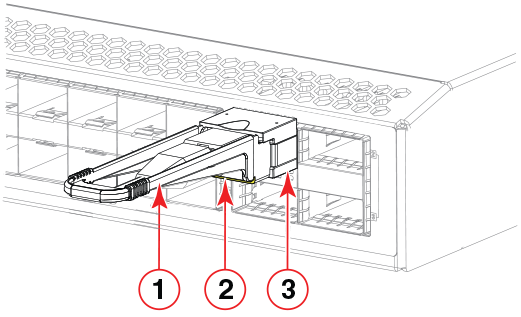Replacing a QSFP28 transceiver
Complete the following steps to remove and then install a new QSFP28 transceiver.
-
Remove any cables that are
inserted into the transceiver.

Note
If your transceiver has an integrated cable, you cannot remove the cable. -
Grasp the transceiver pull tab
and gently pull the transceiver straight out from the port.

Note
Grasp the pull tab near the body of the transceiver to reduce the chances of bending the pull tab. As the transceiver may be hot, always use the pull tab and avoid touching the transceiver body. -
To insert the replacement
transceiver, use the pull tab to carefully push the transceiver into the port.
Transceivers are keyed so that they can only be inserted with the correct
orientation. If a transceiver does not slide in easily, ensure that it is
correctly oriented. Gently push the correctly oriented QSFP28 transceiver until
the latching mechanism clicks.

Note
The following figure uses a generic interface module. Your interface module might look different. Replacing a QSFP28 optical transceiver into blade port
Replacing a QSFP28 optical transceiver into blade port
- Pull tab
- QSFP28 cable connector
- QSFP28 transceiver
-
Position a cable so that the key
(the ridge on one side of the cable connector) is aligned with the slot in the
transceiver. Insert the cable into the transceiver until the latching mechanism
clicks.

Note
If your transceiver has an integrated cable attached, you will not install a cable.When both ends of the cable are inserted and the link is fully established, the LED displays steady green.

Note
Cables are keyed so that they can be inserted in only one way. If a cable does not slide in easily, ensure that it is correctly oriented. - Organize cables to avoid covering LEDs and air vents. Refer to Managing cables for more information.
